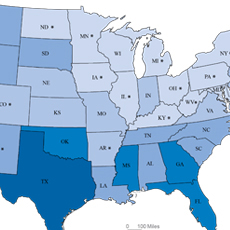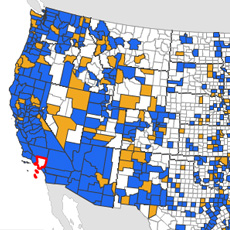Census.gov > Library > Infographics & Visualizations > 2013 > A Century of Population Change in the Age and Sex Composition of the Nation
Library
A Century of Population Change in the Age and Sex Composition of the Nation
September 12, 2013
An important tool for analyzing the age and sex composition of the population is the age-sex pyramid. This age-sex pyramid shows the number of males (on the left) and number of females (on the right) by single years of age.
A century of population change is shown so that population shifts in the shape of the pyramid can be more easily assessed at each point in time. The shape of the pyramid can give important information about the population’s composition. For example, the shapes of the pyramids over the latter part of the 20th century are more typical of developed countries: these feature a broad base with a middle section of nearly the same dimension that then gradually taper off at the oldest ages to a point at the top. The lopsided point at the top of the pyramid indicates differences in the number of males and females at older ages. This is a result of differences in mortality for men and women, where women tend to live longer than men. The Baby Boomer population can be seen in the pyramid as a bulge lasting from 1946 to 1964. The Baby Boom includes people born from mid-1946 to 1964. The Baby Boom is distinguished by a dramatic increase in birth rates following World War II and constitutes one of the largest generations in U.S. history.
SOURCE: Annual estimates of population by single year of age and sex 1900-2000
NOTE: The “tabletops” seen at 75 and 85 reflect data aggregation at the upper end of the range in early decades. National population data for the years 1900 to 1949 exclude the population residing in Alaska and Hawaii. Data for the years 1940 to 1979 cover the resident population plus Armed Forces overseas and for all other years cover only the resident population. The absence of the Armed Forces overseas population is visible in the young male population in 1917-1919. For more information about the annual estimates see the Population Estimates Program website at www.census.gov/programs-surveys/popest/data.html. To download the historical dataset used here see:
1900-1999: www.census.gov/data/tables/time-series/demo/popest/pre-1980-national.html
1980-1989: www.census.gov/data/datasets/time-series/demo/popest/1980s-national.html
1990-2000: www.census.gov/data/datasets/time-series/demo/popest/intercensal-1990-2000-national.html
Recent Data Visualizations
 Population Without Health Insurance
Population Without Health Insurance Population Bracketology
Population Bracketology Measuring Race and Ethnicity Across the Decades: 1790-2010
Measuring Race and Ethnicity Across the Decades: 1790-2010  Where do college graduates work?
Where do college graduates work? Story Maps Illustrate Population Change
Story Maps Illustrate Population Change HIV/AIDS Impact in Africa
HIV/AIDS Impact in Africa Distribution of Hispanic or Latino Population by Specific Origin: 2010
Distribution of Hispanic or Latino Population by Specific Origin: 2010 A Century of Population Change in the Age and Sex Composition of the Nation
A Century of Population Change in the Age and Sex Composition of the Nation  Shifting Occupational Shares
Shifting Occupational Shares Metro Area Density
Metro Area Density Work-Life Earnings
Work-Life Earnings Census Flows Mapper
Census Flows Mapper Migration Between Calif. & Other States
Migration Between Calif. & Other States U.S. Territory and Statehood Status
U.S. Territory and Statehood Status Spoken Languages Other than English
Spoken Languages Other than English Center of Population, 1790-2010
Center of Population, 1790-2010 Population Change by Decade
Population Change by Decade Without A High School Education
Without A High School Education A Decade of State Population Change
A Decade of State Population Change State-to-State Migration for States of 8 Million or More
State-to-State Migration for States of 8 Million or More Population Under 5 Years Old by Congressional District
Population Under 5 Years Old by Congressional District Components of Metro Area Change
Components of Metro Area Change Blooming States
Blooming States Coastline County Population
Coastline County Population Coastline County Population
Coastline County Population I-90 Population Density Profile, 2010
I-90 Population Density Profile, 2010 Second Cities: Keeping Pace with a Booming New York
Second Cities: Keeping Pace with a Booming New York By the Grid: Population Shift to the West and South
By the Grid: Population Shift to the West and South I-10 Population Density Profile, 2010
I-10 Population Density Profile, 2010 Booming Cities Decade-to-Decade, 1830-2010
Booming Cities Decade-to-Decade, 1830-2010 I-5 Population Density Profile, 2010
I-5 Population Density Profile, 2010 Islands of High Income
Islands of High Income The Great Migration, 1910 to 1970
The Great Migration, 1910 to 1970 Following the Frontier Line, 1790 to 1890
Following the Frontier Line, 1790 to 1890 Changing Ranks of States by Congressional Representation
Changing Ranks of States by Congressional Representation Cartograms of State Populations in 1890, 1950, and 2010
Cartograms of State Populations in 1890, 1950, and 2010 Before and After 1940: Change in Population Density
Before and After 1940: Change in Population Density From Physical to Political Geography
From Physical to Political Geography Differential City Growth Patterns
Differential City Growth Patterns I-95 Population Density Profile
I-95 Population Density Profile Increasing Urbanization
Increasing Urbanization Gaining and Losing Shares
Gaining and Losing Shares Top 20 Cities
Top 20 Cities
 Changing Ranks of States by Congressional Representation
Changing Ranks of States by Congressional Representation Cartograms of State Populations in 1890, 1950, and 2010<
Cartograms of State Populations in 1890, 1950, and 2010<